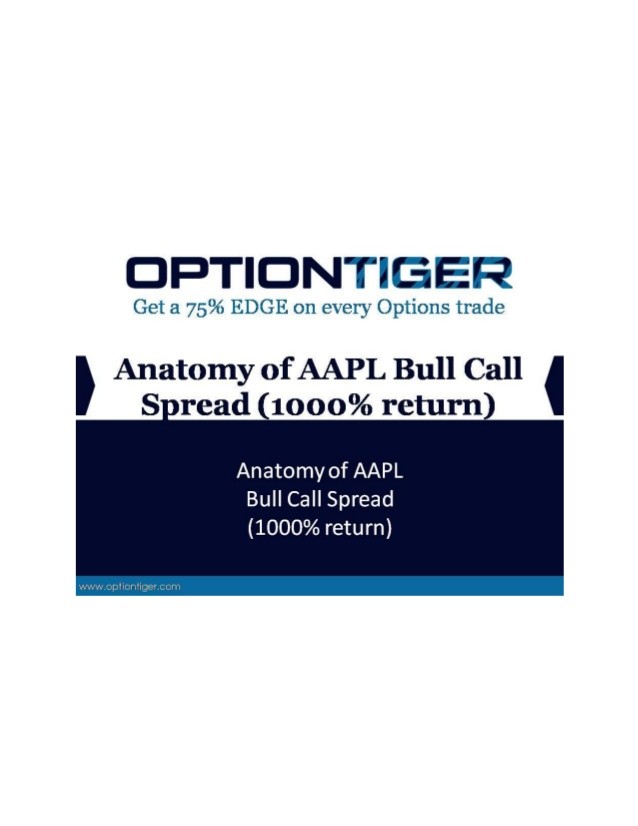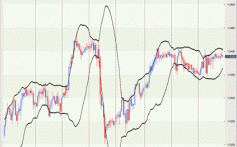How to Use a Bull Call Spread to Trade (AAPL)
Post on: 16 Март, 2015 No Comment

Bull call spreads can result in large returns, but not without risk. A bull call spread involves the purchase of a call option. and the concurrent sale of another, higher-priced call on the same underlying asset with the identical expiration date. The strategy results in a net debit to the option buyer, equal to the difference between the premium paid for buying the lower-priced option and the premium received for selling (or writing ) the higher-priced option.
This net debit is also the maximum loss that can result from a bull call spread, while the maximum profit is equal to the difference in the strike prices of the calls less the net debit. The break-even point for the strategy is equal to the strike price of the lower priced call plus the net debit. (Commissions are ignored here for the sake of simplicity, but would be incurred in opening and closing the option positions.)
The biggest advantage of a bull call spread is that a trader or investor can initiate a bullish position at a fraction of the price of the underlying stock. This is because writing the higher priced call defrays part of the expense involved with buying the lower priced call. This strategy works well if limited gains are expected in a stock, but not as well in a strong bull market because of the greater possibility of the stock being called away at the higher strike price, which would limit the strategy’s upside.
We can illustrate the use of a bull call spread to trade Apple, Inc. (AAPL ), the world’s biggest company by market capitalization as of December 26, 2014, when it closed at $113.99. Let’s say we expect Apple to trend towards its recent record high of $119.75 over the next few months, but not gain much further from that level. Accordingly, we buy a March 2015 $115 call on Apple. The call is trading at $5.25 / $5.65, so we buy it at the ask price of $5.65. Simultaneously, we write a March 2015 $120 call on Apple. This call is trading at $3.55 / $3.65, so we receive the bid price of $3.55 on this call write.
The net debit for this bull call strategy on Apple is thus $2.10 (i.e. $5.65 — $3.55). Note that each option contract has 100 shares as the underlying asset, so the cost in actual dollar terms would be $210 ($2.10 x 100 shares).
Here’s how the strategy would work out in each of the following three scenarios:
Scenario 1 – Apple is trading above $120 (say $122) just before the March 20 expiration date of the calls.
In this case, the $115 call would be trading at a price of at least $7, while the $120 call would be trading at a price of at least $2. Closing the long position on the former and the short position on the latter would result in a gross gain of $5. The net gain would therefore be $2.90 (i.e. $5.00 less $2.10) or 138% of the original investment of $2.10.
Scenario 2 – Apple is trading below $115 (say $110) just before the March 20 expiry of the calls.
In this case, while both the $115 calls and $120 may have some time premium left (depending on how much time is left before option expiration), both calls would very likely expire worthless. We would thus lose our full investment of $210, for a 100% loss.

Scenario 3 – Apple is trading exactly at $117.10 just before the March 20 expiration date of the calls.
In this case, the $115 call would be trading at a price of at least $2.10, while the $120 call would be on track worthless, resulting in a gross gain of $2.10. This exactly offsets the original cost of $2.10, so that the strategy breaks even.
As mentioned earlier, the bull call spread enables a bullish strategy to be implemented at a fraction of the price of the underlying stock. Say we only had about $1,200 as investment capital; this would fetch us only about 10 shares of Apple, but would allow us to implement five contracts of the bull call strategy ($2.10 x 100 x 5 contracts = $1,050). If the trade works out, our account balance would swell to $2,500 ($5 x 100 x 5 contracts), for a return of 138%. But if we had bought 10 Apple shares instead at $113.99, and the stock trades up to $122, our return would only be about $80 or 7% of the original investment.
The flip side is that if Apple trades lower and closes below $115 by option expiration, we would lose the full amount invested in the option strategy, whereas if we had bought 10 Apple shares, we could hold them indefinitely.
Bottom-Line. A bull call strategy enables a bullish position to be implemented at a fraction of the price of the underlying stock. While the risk of this strategy is limited to the net debit (premium paid less premium received), the downside is that the entire amount invested can be lost if the trade does not work out.
Disclosure: The author did not hold positions in any of the securities mentioned in this article at the time of publication.














